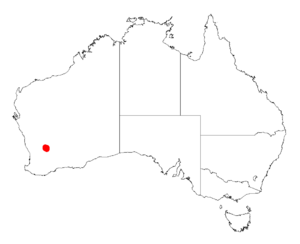Ghost wattle facts for kids
Quick facts for kids Ghost wattle |
|
|---|---|
| Conservation status | |
| Scientific classification | |
| Genus: |
Acacia
|
| Species: |
sciophanes
|
 |
|
| Where the Ghost Wattle grows in Australia | |
The Ghost Wattle, also called the Wundowlin Wattle, is a special type of shrub. Its scientific name is Acacia sciophanes. This plant belongs to the Acacia family, which is known for its many different wattle species.
The Ghost Wattle grows only in a small part of Western Australia. This means it is endemic to that area. Because it's so rare, it was officially declared a rare plant in 1995. Today, it is listed as an endangered plant. This means it is at high risk of disappearing forever if we don't protect it.
Contents
What Does the Ghost Wattle Look Like?
This unique shrub usually grows to be about 1.5 to 3 meters (5 to 10 feet) tall. It has a spread-out, open shape with many branches. Some plants might have several main stems that grow from near the ground. Its branches can be a bit zig-zaggy and droopy, sometimes looking a bit sticky from resin.
Like most Acacia plants, the Ghost Wattle doesn't have typical leaves. Instead, it has phyllodes. These are flattened leaf stalks that act like leaves. The phyllodes of the Ghost Wattle are thin and look like coarse threads. They are about 9 to 15 centimeters (3.5 to 6 inches) long and only about 2 millimeters (0.08 inches) wide. They have four clear ridges and grooves, and their tips are often hooked.
Flowers and Seed Pods
The Ghost Wattle blooms from September to November. During this time, it produces bright yellow flowers. These flowers grow in round clusters, called flower-heads. Each flower-head is about 7 to 8 millimeters (0.28 to 0.31 inches) across and contains 25 to 31 small, golden flowers packed closely together. These flower-heads grow alone or in pairs where the phyllodes meet the stem.
After the flowers, the plant forms seed pods. These pods are firm, hairy, and shaped like cylinders. They are straight or slightly curved, growing up to 12 centimeters (4.7 inches) long and about 2 millimeters (0.08 inches) wide. The pods are a bit bumpy where each seed sits inside. The seeds themselves are shiny and mottled with light and dark tan colors. They are oblong or oval-shaped, about 3 to 5 millimeters (0.12 to 0.20 inches) long. Each seed has a white aril, which is a fleshy covering.
How Was the Ghost Wattle Named?
The Ghost Wattle was first officially described by a botanist named Bruce Maslin. He wrote about it in a scientific journal called Nuytsia in 1977.
Later, in 2003, another botanist named Leslie Pedley reclassified it. He gave it a different scientific name, Racosperma sciophanes. However, in 2005, it was moved back to the Acacia group.
The Ghost Wattle is closely related to another plant called Acacia anfractuosa. It also looks similar to the Acacia merinthophora.
Where Does the Ghost Wattle Grow?
The Ghost Wattle lives in a very small area in the Wheatbelt region of Western Australia. Its entire natural home is less than 10 square kilometers (3.9 square miles) in size. This area is near the town of Mukinbudin, specifically about 18 kilometers (11 miles) southwest of the town, between Mukinbudin and Bencubbin.
The population of Ghost Wattles in this area is very spread out and broken into smaller groups. The number of adult plants is still going down.
Its Habitat
This plant prefers to grow in sandy soil that has gravel in it, usually over a type of rock called laterite. It grows as part of shrubland communities. These are areas where shrubs are the main type of plant. Other plants found with the Ghost Wattle include Acacia neurophylla, Acacia merrickiae, Allocasuarina corniculata, and Allocasuarina campestris. There are also some hummock grasses in these areas.
Scientists have found two main groups of Ghost Wattles, which are further divided into seven smaller groups. In total, there are about 484 individual Ghost Wattle plants known to exist.


